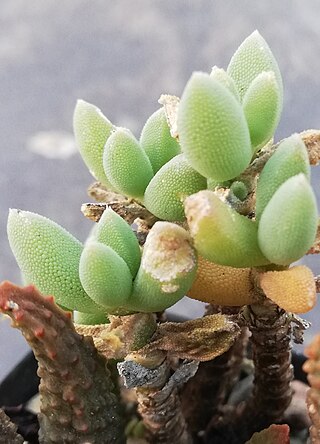
Rhipsalis is a genus of epiphytic flowering plants in the cactus family, typically known as mistletoe cacti. They are found in parts of Central America, the Caribbean and northern regions of South America. They also inhabit isolated locations in Africa and Asia, and are the only cactus group naturally occurring in the Old World. This is the largest and most widely distributed genus of epiphytic cacti.

Acrodon is a genus of ice plants from South Africa. It comprises five species, mostly endangered and all restricted to the southern Cape regions of the Western Cape and Eastern Cape Provinces, South Africa.

Trichodiadema calvatum is succulent plant of the genus Trichodiadema, native to the Western Cape Province, South Africa, where it is found in shales, in open rocky areas within Renosterveld vegetation.

Trichodiadema occidentale is succulent plant of the genus Trichodiadema, native to the Western Cape Province, South Africa, where it grows in rocky shale or limestone hills in the Overberg region, and especially in disturbed areas.

Trichodiadema pygmaeum is succulent plant of the genus Trichodiadema, native to the Western Cape Province, South Africa, where it is found in fine-grained soils in the regions of Bredasdorp and Swellendam.

Drosanthemum micans, is a succulent plant in the ice plant family, Aizoaceae, indigenous to the Robertson Karoo and Overberg regions of the Western Cape Province, South Africa.

Drosanthemum lavisii is a succulent plant in the ice plant family, Aizoaceae, indigenous to the Overberg region of the Western Cape Province, South Africa.
Drosanthemum quadratum is a succulent plant in the ice plant family, Aizoaceae, indigenous to the Overberg region of the Western Cape Province, South Africa.

Trichodiadema setuliferum is a succulent plant of the genus Trichodiadema, native to the Karoo regions of the Cape Provinces, South Africa.

Acrodon bellidiflorus, the common tiptoothfig, is a mesemb species from South Africa.
Acrodon caespitosus, the Potberg tiptoothfig, is a species of mesemb from South Africa.
Acrodon parvifolius, the Botriver tiptoothfig, is a species of mesemb from South Africa. This species, which grows close to the ground, can best be recognised by its small, thin leaves and its flowers, which form a dome in the middle.
Acrodon subulatus, the Overberg tiptoothfig, is a species of mesemb from South Africa.

Cheiridopsis speciosa is a species of plant from South Africa.
Cheiridopsis schlechteri is a species of plant from South Africa. It is a succulent plant that grows in dry habitats.
Cheiridopsis turbinata is a succulent plant from South Africa.
Cheiridopsis umdausensis is a species of succulent plant from South Africa.
Cheiridopsis velox is a species of succulent plant from South Africa.
Cheiridopsis pilosula is a species of succulent plant from Namaqualand in the Northern Cape of South Africa.
Cheiridopsis ponderosa is a species of succulent plant from South Africa.








